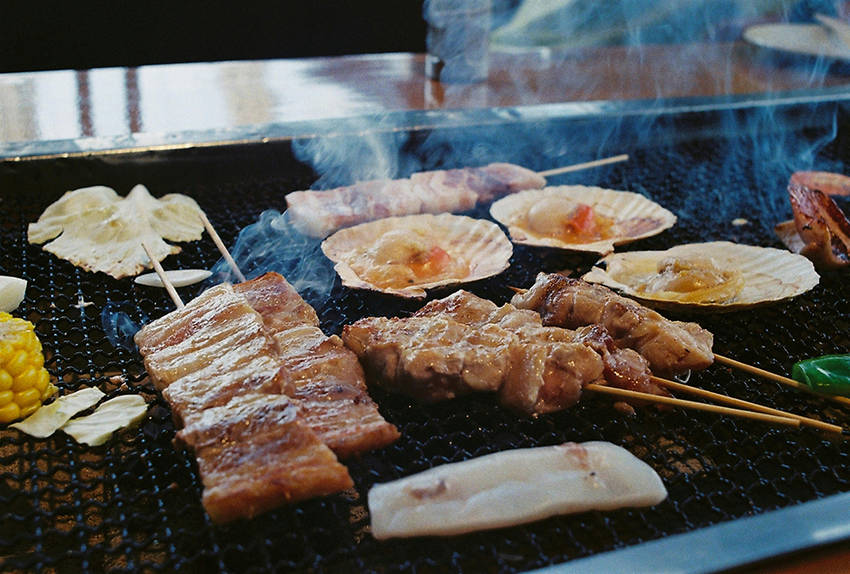東京の名物料理
- 寿司:特に築地市場(現在の豊洲市場)で新鮮な魚介類を使った寿司は有名です。江戸前寿司と呼ばれるスタイルが特徴です。
- 天ぷら:江戸時代からの伝統料理で、新鮮な海老や野菜をサクサクの衣で揚げたものです。専門店では、高品質な食材と揚げ方にこだわった天ぷらを楽しめます。
- そば:日本全国で人気のあるそばですが、東京では「江戸前そば」が特に有名です。シンプルなかけそばやもりそばから、天ぷらそばなどバリエーションが豊富です。
- うなぎの蒲焼き:東京のうなぎは、タレで香ばしく焼かれた蒲焼きが定番です。夏のスタミナ食として親しまれています。
- もんじゃ焼き:浅草や月島が特に有名なもんじゃ焼きは、鉄板で焼いて食べる東京独特のお好み焼きのような料理です。キャベツ、海鮮、もちなど様々な具材が使われます。
- どじょう鍋:どじょうを使った鍋料理で、特に江戸時代から続く老舗のどじょう鍋店が有名です。
- 洋食:明治時代以降、西洋料理が取り入れられ、東京では独自の進化を遂げました。カレーライス、ハヤシライス、オムライスなどが代表的です。
- たい焼き:甘い餡を入れた魚の形をした焼き菓子で、浅草などの下町で特に人気があります。
- 和菓子:浅草などの伝統的な和菓子店では、あんみつ、だんご、どら焼きなどが楽しめます。
大阪の名物料理
- たこ焼き:大阪を代表するB級グルメで、小麦粉の生地にタコの具を入れ、鉄板で丸く焼き上げます。外はカリッと、中はとろっとした食感が特徴です。
- お好み焼き:キャベツや豚肉、シーフードなどの具材を小麦粉の生地と混ぜて鉄板で焼き、ソースやマヨネーズ、かつお節、青のりをかけて食べます。
- 串カツ:様々な具材(肉、野菜、魚介など)を串に刺し、パン粉をつけて揚げた料理です。特製のソースにつけて食べます。
- うどん:特に「かすうどん」が有名で、牛の小腸を揚げた「かす」をトッピングしたうどんです。独特のコクと旨味があります。
- 豚まん:551蓬莱の豚まんが有名で、大きなサイズとジューシーな具が特徴です。
- たこせん:たこ焼きをせんべいで挟んだ軽食で、子供から大人まで人気があります。
- きつねうどん:甘く煮た揚げ(油揚げ)が乗ったうどんで、大阪では定番の一品です。
- いか焼き:いかを使った鉄板焼きで、小麦粉の生地にいかを入れ、薄く焼き上げたものです。
京都の名物料理
- 湯豆腐:清らかな水を使って作られた豆腐を、昆布だしで軽く温めていただくシンプルな料理です。特に南禅寺周辺の湯豆腐は有名です。
- 京漬物:しば漬け、千枚漬け、すぐき漬けなど、京都ならではの風味豊かな漬物があります。お茶漬けやおにぎりの具としても親しまれています。
- 京懐石:季節の食材を使った美しい料理が少量ずつ提供される形式で、見た目と味を同時に楽しむことができます。茶懐石から発展したもので、茶の湯の心を感じさせます。
- 八つ橋:ニッキ風味の生地であんこを包んだ和菓子で、焼き八つ橋や生八つ橋があります。お土産としても人気です。
- 鱧料理:夏の京都を代表する料理で、骨切りされた鱧を使った天ぷらやしゃぶしゃぶが有名です。
- 抹茶スイーツ:京都は宇治抹茶の産地としても知られ、抹茶を使ったパフェやアイスクリーム、ケーキなどのスイーツが豊富です。
- にしんそば:甘く煮たにしん(鰊)を乗せた温かいそばで、伝統的な京都の冬の味覚です。
- 豆腐料理:湯豆腐以外にも、揚げ出し豆腐や豆腐ステーキなど、さまざまな豆腐料理が楽しめます。
- おばんざい:京都の家庭料理で、季節の野菜を中心とした素朴で栄養豊富なおかずが特徴です。小鉢に盛られて提供されることが多いです。
その他の地域にも、その土地ならではの名物料理があります。日本に行った際には、その地域の名物料理を楽しんでみてください。
- 寿司:特に築地市場(現在の豊洲市場)で新鮮な魚介類を使った寿司は有名です。江戸前寿司と呼ばれるスタイルが特徴です。
- 天ぷら:江戸時代からの伝統料理で、新鮮な海老や野菜をサクサクの衣で揚げたものです。専門店では、高品質な食材と揚げ方にこだわった天ぷらを楽しめます。
- そば:日本全国で人気のあるそばですが、東京では「江戸前そば」が特に有名です。シンプルなかけそばやもりそばから、天ぷらそばなどバリエーションが豊富です。
- うなぎの蒲焼き:東京のうなぎは、タレで香ばしく焼かれた蒲焼きが定番です。夏のスタミナ食として親しまれています。
- もんじゃ焼き:浅草や月島が特に有名なもんじゃ焼きは、鉄板で焼いて食べる東京独特のお好み焼きのような料理です。キャベツ、海鮮、もちなど様々な具材が使われます。
- どじょう鍋:どじょうを使った鍋料理で、特に江戸時代から続く老舗のどじょう鍋店が有名です。
- 洋食:明治時代以降、西洋料理が取り入れられ、東京では独自の進化を遂げました。カレーライス、ハヤシライス、オムライスなどが代表的です。
- たい焼き:甘い餡を入れた魚の形をした焼き菓子で、浅草などの下町で特に人気があります。
- 和菓子:浅草などの伝統的な和菓子店では、あんみつ、だんご、どら焼きなどが楽しめます。
大阪の名物料理
- たこ焼き:大阪を代表するB級グルメで、小麦粉の生地にタコの具を入れ、鉄板で丸く焼き上げます。外はカリッと、中はとろっとした食感が特徴です。
- お好み焼き:キャベツや豚肉、シーフードなどの具材を小麦粉の生地と混ぜて鉄板で焼き、ソースやマヨネーズ、かつお節、青のりをかけて食べます。
- 串カツ:様々な具材(肉、野菜、魚介など)を串に刺し、パン粉をつけて揚げた料理です。特製のソースにつけて食べます。
- うどん:特に「かすうどん」が有名で、牛の小腸を揚げた「かす」をトッピングしたうどんです。独特のコクと旨味があります。
- 豚まん:551蓬莱の豚まんが有名で、大きなサイズとジューシーな具が特徴です。
- たこせん:たこ焼きをせんべいで挟んだ軽食で、子供から大人まで人気があります。
- きつねうどん:甘く煮た揚げ(油揚げ)が乗ったうどんで、大阪では定番の一品です。
- いか焼き:いかを使った鉄板焼きで、小麦粉の生地にいかを入れ、薄く焼き上げたものです。
京都の名物料理
- 湯豆腐:清らかな水を使って作られた豆腐を、昆布だしで軽く温めていただくシンプルな料理です。特に南禅寺周辺の湯豆腐は有名です。
- 京漬物:しば漬け、千枚漬け、すぐき漬けなど、京都ならではの風味豊かな漬物があります。お茶漬けやおにぎりの具としても親しまれています。
- 京懐石:季節の食材を使った美しい料理が少量ずつ提供される形式で、見た目と味を同時に楽しむことができます。茶懐石から発展したもので、茶の湯の心を感じさせます。
- 八つ橋:ニッキ風味の生地であんこを包んだ和菓子で、焼き八つ橋や生八つ橋があります。お土産としても人気です。
- 鱧料理:夏の京都を代表する料理で、骨切りされた鱧を使った天ぷらやしゃぶしゃぶが有名です。
- 抹茶スイーツ:京都は宇治抹茶の産地としても知られ、抹茶を使ったパフェやアイスクリーム、ケーキなどのスイーツが豊富です。
- にしんそば:甘く煮たにしん(鰊)を乗せた温かいそばで、伝統的な京都の冬の味覚です。
- 豆腐料理:湯豆腐以外にも、揚げ出し豆腐や豆腐ステーキなど、さまざまな豆腐料理が楽しめます。
- おばんざい:京都の家庭料理で、季節の野菜を中心とした素朴で栄養豊富なおかずが特徴です。小鉢に盛られて提供されることが多いです。
その他の地域にも、その土地ならではの名物料理があります。日本に行った際には、その地域の名物料理を楽しんでみてください。
Specialty Dishes of Travel Destinations
Specialties of Tokyo
- Sushi: Sushi made with fresh seafood from the Tsukiji Market (now Toyosu Market) is especially famous. The style of sushi is called Edomae Sushi.
- Tempura: Tempura, a traditional dish from the Edo period, consists of fresh shrimp and vegetables deep-fried in a crispy batter. At specialty restaurants, you can enjoy tempura made with high-quality ingredients that’s also fried in a specific way.
- Soba: Soba is popular throughout Japan, but "edomae-soba" is especially famous in Tokyo. There are many variations of soba, from simple kakesoba and morisoba to tempura soba.
- Kabayaki eel: The standard Tokyo eel is kabayaki, perfectly grilled and paired with a sauce. It is a popular summer stamina food.
- Monjayaki: Monjayaki, especially famous in Asakusa and Tsukishima, is a unique okonomiyaki-like dish served on a teppan grill. They use a variety of ingredients, including cabbage, seafood, and rice cake.
- Dojo-nabe: A hot pot dish using loach, especially famous at long-established loach hot pot restaurants that have been in business since the Edo period.
- Western food: People introduced Western cuisine to Tokyo during the Meiji era (1868-1912) and has since evolved uniquely since then. Typical examples include curry rice, hashed rice, and omelet rice.
- Taiyaki: Fish-shaped baked sweets filled with sweet red bean paste, especially popular in downtown areas such as Asakusa.
- Wagashi: Stores in Asakusa and other areas feature anmitsu, dango, dorayaki, and other traditional Japanese sweets.
Specialties of Osaka
- Takoyaki: Osaka's representative B gourmet food, they make takoyaki with a dough made of flour with an octopus filling before grilling in a round on a griddle, well-known for its crispy exterior and softer interior texture.
- Okonomiyaki: Chefs mix cabbage, pork, and seafood with a flour batter before grilling it on a griddle and serving it with an okonomiyaki sauce, mayonnaise, bonito flakes, and green laver.
- Kushikatsu: To make kushikatsu, they skewer various ingredients like meat, vegetables, seafood, or other ingredients, breadcrumbs and deep fry it. Then, people dip it in a special sauce before eating it.
- Udon noodles: "Kasu udon", which is udon topped with “kasu”, or deep-fried beef small intestines, is especially famous in Osaka. It has a unique rich and delicious flavor.
- Pork buns: 551 Hourai's pork buns are famous for their large size and juicy filling.
- Takosen: A light snack consisting of takoyaki (octopus balls) sandwiched between rice crackers, popular among both children and adults.
- Kitsune Udon: Udon noodles topped with sweetened deep-fried tofu (abura-age), a staple dish in Osaka.
- Ika-yaki: Teppan-yaki using squid, squid is placed in a flour batter and baked thinly.
Specialties of Kyoto
- Yudofu: A simple tofu dish made with pure water and served lightly heated in kombu (kelp) broth. Yudofu around Nanzenji Temple is especially famous.
- Kyoto pickles: Kyoto is famous for its flavorful pickles, including Shibazuke, Senmaizuke, and Sugukizuke. They are also popular as ochazuke pickles.
- Kyo-kaiseki: A form of kaiseki where they prepare dishes using seasonal ingredients served in small portions, letting diners enjoy both the appearance and taste of the food at the same time. Developed from chakaiseki, it evokes the spirit of chanoyu (tea ceremony).
- Yatsuhashi: A Japanese sweet consisting of anko (sweet bean paste) wrapped in Nikki-flavored dough, available in baked and fresh forms. They’re especially popular as souvenirs.
- Hamo (conger eel) cuisine: A typical summer dish in Kyoto, hamo tempura and shabu-shabu, where they cut hamo (conger eel) into small pieces, are very popular.
- Matcha sweets: Kyoto is also known for its Uji green tea, so there’s a wide variety of sweets using matcha, such as parfaits, ice cream, and cakes.
- Nishin-soba: Hot soba noodles topped with sweetened herring, nishin-soba is a traditional Kyoto winter delicacy.
- Tofu Dishes: In addition to yudofu, you can enjoy a variety of tofu dishes such as deep-fried tofu and tofu steak.
- Obanzai: Kyoto's home-style cuisine, characterized by simple yet nutritious side dishes made with seasonal vegetables. It is often served in small bowls.
Other regions also have their own local specialties. When you visit Japan, try to enjoy the local specialties of that region.
sign up for the Japanese-Online Newsletter
__..-・**・-..__..-・**・-.._ あいうえお かきくけこ さしすせそ たちつてと なにぬねの はひふへほ まみむめも やいゆえよ らりるれろ わゐうゑを ん __..-・**・-..__..-・**・-.._
#JapaneseOnline #LearningJapanese #FreeJapaneseLessons #JapaneseVideoLearning #JapaneseAnime #Anime #JapaneseFood #Bloguru

